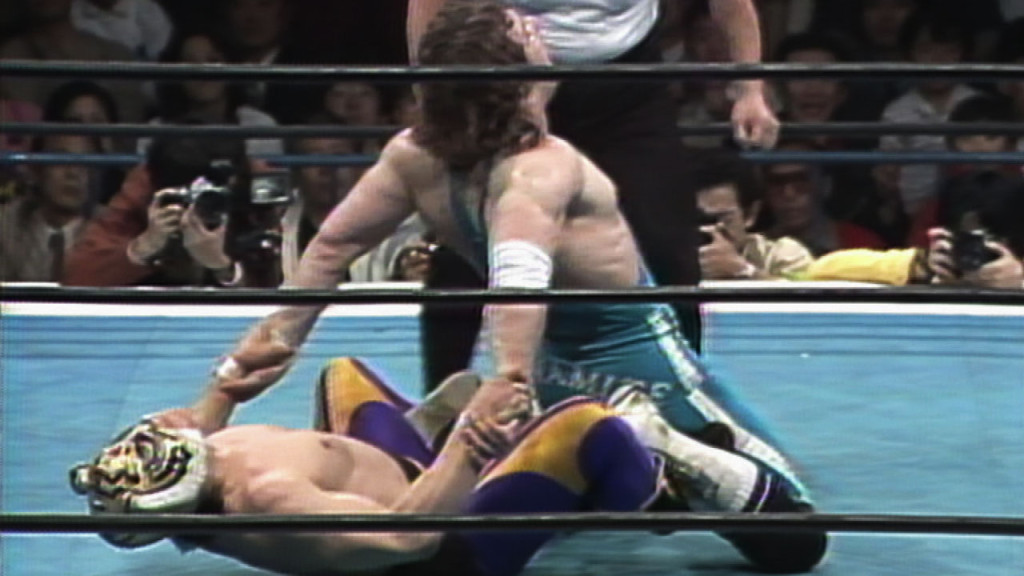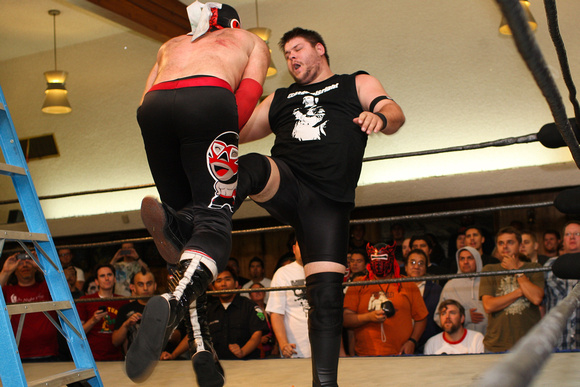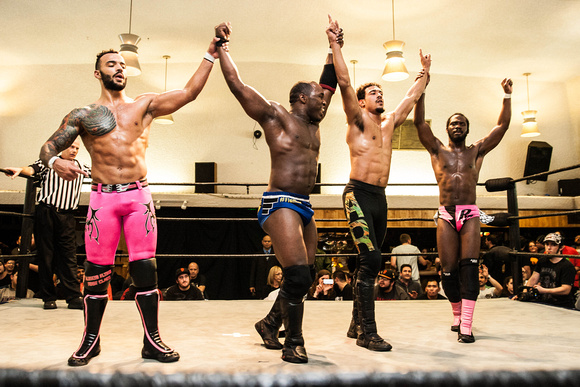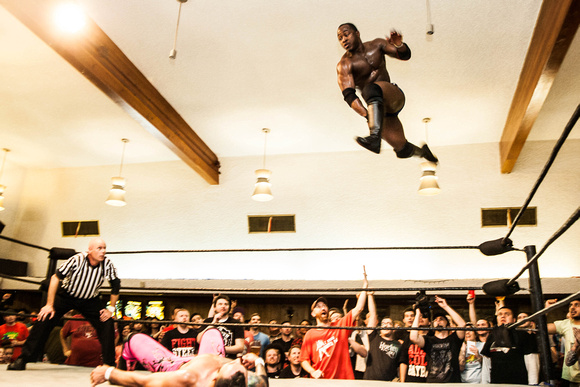
Tiger Mask I (there have been four) and Dynamite Kid in the first ever Five Star Match. (Source: WWE.com)
Pro wrestling is a weird bastard art, and if you’re unfamiliar with its intricacies, the hordes of people in your social media circles obsessively pontificating about it every Monday night must be a truly confounding experience. Let our very own Dominic Griffin, lifelong wrestling enthusiast, teach you a little something right here, In This Very Ring…
Art is subjective, but every medium has some semi-agreeable standard for critical measurement. Movies generally follow a star system or an alphabetical school grading scale. For a long time, hip hop music lived for the 5 Mic rating from The Source magazine. Wrestling is art, and for many, the measuring stick for rating the quality of a match was popularized by one man, preeminent wrestling journalist Dave Meltzer. For a few decades, Meltzer’s self published Wrestling Observer Newsletter utilized the Five Star Rating system, allegedly developed by wrestling manager/booker, Jim Cornette.
Matches are rated on a scale from negative five stars (in the rare case of spectacular catastrophe) to five stars (reserved for unimpeachable classics of the form.) As wrestling’s biggest, most credible critic, Meltzer’s opinion is often treated like manna, forming a standard adhered to by a legion of fans who will watch a match and immediately begin arguing over where it should land on the scale.
The scale uses several factors to determine the quality of a match. One is work rate, which is an insider term used to define the ratio of actual wrestling moves to rest holds. A rest hold could be a leg lock or a sleeper hold. Basically, any time two wrestlers are stationary in the ring and the announcers are talking about how one guy is working over the other, but neither is actually moving? Rest hold. It exists for pacing and to give performers chances to breathe. Work rate, in a film, would be how many car chases an action movie has versus the number of “laying low in a safe house discussing exposition” scenes there are.
Another factor would be the relationship between the two performers and whether or not they have a history that enriches the proceedings, or if the match is furthering an ongoing feud, and if it is, how well the matche moves that particular story forward. They’ve never had a five star match, but former teammates Kevin Steen and El Generico had a nasty grudge feud that traversed multiple wrestling promotions. The subtext and scorn present in all of their match-ups elevated even their most pedestrian performances to a high level.

Hatred springs eternal with El Generico and Kevin Steen. (Source: Devin Chen Photography)
Perhaps the biggest factor is the variety of moves used. Some matches require basic punches and kicks, but others might utilize a more unorthodox choreography incorporating innovative maneuvers and risk taking acrobatics. How these moves are used to physically tell the story are more important than their extravagance. Two guys doing insane flippy moves for thirty minutes might look cool, but that is what is referred to as a spotfest: a meaningless series of cool moments, or spots. Spotfests rarely get five stars (a worthy exception would be Do Fixer vs Blood Generation from ROH’s Supercard of Honor 2006, which is the Mona Lisa of spotfests). Audience reaction is also key. You can put on a technical wrestling clinic for the critics but if the crowd is dead, then what’s the point?
Meltzer has bestowed the five star rating on a scant 73 matches in 34 years of publication. A mere five of these matches come from WWF/WWE. Five. The biggest wrestling company on Earth, in its illustrious history, has only had five! Only ONE since the year 2000: CM Punk and John Cena’s main event title match from 2011’s Money In The Bank. Meltzer is often criticized for being too beholden to Japanese wrestling. All Japan legend Mitsuhara Misawa, personally, was in 24 of the 73 matches Meltzer has given a perfect score, to give you an idea of how subjective bias fits into the picture. It’s essentially the same reason Star Wars never won an Oscar.
I’ve only seen maybe a third of Meltzer’s perfect matches, one of them live (ROH’s dream match Samoa Joe vs All Japan legend Kenta Kobashi, in New York City. It. Was. Beautiful.). I generally agree with his ratings, but there have been times I vehemently did not. Last year, two of New Japan Pro Wrestling’s stars Tomohiro Ishii and Katsuyori Shibata had a match during the annual G1 Climax tournament that the entire internet collectively orgasmed for, Meltzer among them. I dug it enough, and understand why it got the five star nod, but I just wasn’t feeling it like that. I’ve since become a big fan of Ishii and Shibata for other matches, but eleven minutes of two dudes stiff kicking each other and no selling [1] the damage felt too much like a Dragonball Z rerun for my tastes. Here it is, if you really like kicking.
The star rating system is very popular on internet wrestling forums, where you’re likely to find MOTYC (Match of the Year candidate) threads populated with diehards dissecting every televised wrestling match they can get their hands on, perpetually in search of the One True Match of The Year. Because of the sheer volume of wrestling in the world, by year’s end they’re usually left with massive lists, grouping their favorites down to quarter star divisions. I mean, honestly, it’s hard to say what makes a 4 1/4 star match different than a 3 3/4 star one, but I admire the dedication and search for quality work.
It being the middle of the year, and honestly a banner one for superior in-ring product, there’s quite a few MOTYCs out there for 2014. Now that you’re acquainted with the rubric, I thought I would highlight two of my favorite matches of the year thus far, and try to illustrate the difference between a really good match and what I would consider a five star match. It just so happens both specimens are tag team matches.
The first match is from Pro Wrestling Guerilla’s DDT4 (Dynamite Duumvirate Tag Team Title Tournament) back at the end of January. PWG is one of my favorite indie promotions. They stay in Reseda, California and their crowds are notoriously the best in all of wrestling. Small, but loyal and vocal. Reseda is sort of the best of all possible worlds for young wrestlers. If you can get over there, they will love you forever. Four such individuals are Ricochet, Rich Swann, AR Fox, and ACH, all young, all black, all arguably the best high flyers in the world right now.
Here is a taste of the match. If you are at all enticed, I cannot recommend buying the DVD enough. (Match begins at 2:02.)
Ricochet and Swann have been teaming for a little while as The Inner City Machine Guns (a play on former TNA team The Motor City Machine Guns). Like any trivia night, it’s customary for new teams to craft ridiculous team names for DDT4. AR Fox and ACH hadn’t teamed regularly before, but dubbed themselves The African American Wolves (a play on former PWG team The American Wolves, going so far as to mimic Davey Richards and Eddie Edwards during their entrance). Not to be outdone, ‘Chet and Swann redubbed themselves Malcom Degeneration-X and The Martin Luther Kings of Wrestling. Since PWG is infinitely more easygoing than other promotions, starting a match with a clever name-off is commonplace, but this playful preamble served as misdirection for a rather hard hitting encounter.

(L to R) Ricochet, ACH, AR Fox, and Rich Swann. (Source: Devin Chen Photography)
Each of these four contenders wrestle in a very similar style, which can make for a boring, seen-it-already type vibe of mirror effects. Smartly, the guys played up what sets each of them apart. Swann, the shortest of the bunch, moved aggressively and with a chip on his shoulder, repeatedly mimicking moves he shares with ACH and AR Fox with a mean streak. Fox, the lankiest and the least careful of his own well being, took more risks and put his own body on the line to mask his technical weaknesses. The real stars here were Ricochet and ACH. Ricochet, himself leagues ahead of his peers, was finally able to play the wise, world-traveled veteran instead of the wiry underdog. ACH, a lovable hero who incorporates animé references into his moveset, took the biggest risk of all, expertly playing a heel role to give the match an injection of real conflict.
Reseda’s crowd is hard to anger, as they know the business and love the competitors, even the heels, but ACH played his usual cockiness up a notch from confident rookie to asshole hotshot in the moments where the crowd’s interest waned, knowing that as much as people like to cheer, they always need someone to root against. His ground game savagery and sneering impersonation of the crowd’s singing along to Lionel Ritchie’s “All Night Long” (Ricochet and Swann’s entrance theme) offered the necessary contrast. This elevated the quarterfinal tournament bout from being an exhibition spotfest of the best aerial wrestling on the planet into a legitimate grudge fight between two teams of tyros trying to make it big.

ACH is “Jumpin’ Like Jordan.” (Source: Devin Chen Photography)
Seeing Ricochet and Swann overcome ACH’s grittiness with superior acrobatics and more synergistic teamwork provided a satisfying climax, and gave the winning team some serious momentum going into the next round. It’s an exciting sprint of a match. What keeps it from being five stars is its run time. The match could have functioned better if it was tighter and didn’t take half the bout to find its narrative footing. It’s clear all four men were more interested in pleasing the Reseda crowd and everyone wanted to garner adoration, but it took ACH making himself the villain to pull it all together. Imagine if they figured that out from jump?
Which brings us to my match of the year, a five star extravaganza, six-man tag match between The Shield and The Wyatt Family from WWE’s Elimination Chamber in February. I’ve sang the praises of these two teams before. In the last year they have been the two most prominent stables in the WWE. From the moment the Wyatts debuted last summer, fans have clamored to see the two (at the time) heel teams go at it. Heel versus heel matches are rare. As fun as it is, seeing two villains fight is a hard trick to pull off. What makes this case special is that both teams are over [2] as fuck. Though both teams work as bad guys, they’re so beloved that they get cheered wherever they go. The Shield, three mercenaries who fight for the nebulous concept of “justice” but work as attack dogs for the evil Authority of WWE executives Triple H and Stephanie McMahon, and The Wyatt Family, backwater cultists who vow to fight “the machine” by brutalizing the misguided heroes of the status quo. These guys were made for each other.
First, some hype.
Remember, wrestling is the art of taking two opposing forces and making you want to pay for the privilege of seeing them fight. The craft on display in the buildup to this match was exemplary. If you have the WWE Network, I highly suggest you look this match up. If you don’t, for whatever reason, it’s on YouTube somewhere if you look hard enough.
If audience participation matters, the crowd for The Shield vs The Wyatts alone would put this match over the top. Fans were losing their minds before a single punch was thrown. Once things get going, it is thirty minutes of wall-to-wall action. There are ebbs and flows in the violence, but what sets it a cut above is the characterization. Even if you don’t watch any of the promos, or don’t have an intimate knowledge of the six men’s respective gimmicks, watching this one match will give you a clear idea of who each man is and how they fight.
Roman Reigns, the handsome Samoan Prince, wrestles methodically with bursts of Godly power, a conduit for charismatic force. His teammate Seth Rollins wrestles smart when it matters, a tactical mind with no wasted movement, but a reckless daredevil when the chips are down. Dean Ambrose is an unpredictable flurry of childish fury and he basically wrestles like Rorschach from Watchmen. This is a team that spent a year dismantling the top stars of the company through an effective use of teamwork and proper planning.
Bray Wyatt is a cult leader, vocally calling the shots, only tagging into the match when his team has the advantage, never risking his own well-being. His followers Luke Harper and Erick Rowan are both titanic behemoths in grungy bayou duds, but even among them there is a sense of hierarchy. Luke is clearly the more intelligent follower, Erick his second. They take turns hurling vicious clotheslines and overpowering their opponents. Harper is willing to throw his entire body at someone outside the ring, an extremely risky feat for someone of his size.

“I welcome this war!” – Bray Wyatt, Eater of Worlds (Source: WWE.com)
Most wrestlers have characters, but few apply that character in every moment of a match. There are seams where you don’t see that WWE superstar, but rather a tired athlete trying to remember what comes next. Not with these two teams. There is room for improvisation, to be sure, but the match manages to follow a strong, three-act narrative, playing on the expectations built by previous matches and the audience’s understanding of how each team operates in the ring.
In the lead-up to this match, dissent began to form among The Shield and here, when Dean disappears into the crowd during the match’s third act, it pours a gallon of gasoline onto the break-up rumor fire. The Shield operates best as a cool, collected unit, but here, that teamwork falls apart and they are felled by a superior sense of conviction. The Wyatts outnumber fallen soldier Roman in the end, overpowering him the same way The Shield has so many of their victims. The cruel sense of irony tinged with a nagging sense of inevitability caps off a story as old as time: no matter how long you’re on top, there’s always someone better.
There have been three rematches since, but to date, none have touched the spark that ignited this rivalry. There’s a powerful, engrossing story told from bell to bell, and like any good tale, it leaves you wanting more. To me, that’s five stars.
I’m sorry Meltzer didn’t agree.
(For those interested, here’s a list of Meltzer’s five star matches, with video links, courtesy of Reddit. Personally, I’d start with Ric Flair vs. Rick Steamboat, but choose your own path.)
[1] To “No Sell” is to brush off a move performed on you. Sometimes this makes sense, ie: with a character like The Undertaker, who no sold the first decade of his career because he was supposed to be an untouchable monster, or in moments of intense fighting spirit, like an underdog kicking out at one to prove he’s still in the fight. Other times, no selling is the wrestling equivalent of playing improv with Michael Scott.
[2] Over is being popular. If you’re a bad guy, being hated is over. It means you are eliciting the proper response from a crowd.
Follow @DeadshirtDotNet and @captain_fuck on Twitter where we’ll be available to answer any possible question you could have about wrestling.

